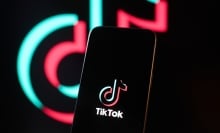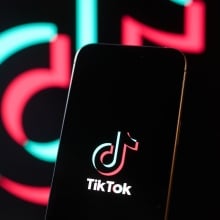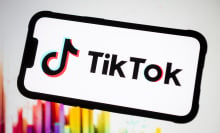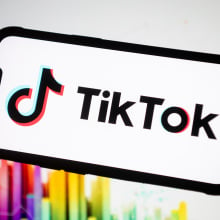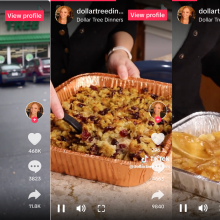In 1866, Gustave Courbet painted a provocative icon of modern art: The Origin of the World. Hung in Musée d'Orsay in Paris, the painting shows a woman's thighs, torso, part of one breast and her hairy genitals. It's one of the most beautiful and powerful paintings of all time.
Jenna Gribbon, a queer figurative painter in Brooklyn, frequently paints her partner, Mackenzie Scott, in a similar vein. In one painting, Scott is laying naked, her breasts and thighs and pubic hair and fluorescent pink nipples painted across a massive canvas.
"I can't think of any other canonized painting that continues to be so shocking," Gribbon said in an interview with Vogue of her admiration for The Origin of the World. "I would love that painting more if it was painted by a woman, but the premise that we all come from a woman's body is a very human one. It's the opposite of objectifying a woman's anatomy — it considers the physical and spiritual reality of a woman's body."
Tweet may have been deleted
Gribbon and Courbet's paintings have much in common, but there's a distinct difference between the two: the gender of their creators. In my mind, both artists have painted women in what some might argue as the female gaze — a term in feminist theory that refers to the representation of women in art as subjects with agency. But plenty of art historians argue that Courbet's painting had to have been created from the male gaze because the woman in the painting doesn't appear to have much obvious autonomy; she doesn't even have a face.
It's a much debated topic, and this term, which was originally used in film, has made its way onto the depths of the art world. Now, it's being misconceived on TikTok.
What is the female gaze?
The female gaze wasn't coined until after feminist film theorist Laura Mulvey first began dissecting the male gaze in her 1975 essay "Visual Pleasure and Narrative Cinema," in which she writes that the male gaze projects a male fantasy onto the female figure on film. Under the male gaze, women are to be looked at and displayed, with their "appearance coded for strong visual and erotic impact so that they can be said to connote to-be-looked-at-ness."
Through the male gaze, a woman isn’t actually a person at all; she’s a plot device used to advance the man’s story. "She is the one, or rather the love or fear she inspires in the hero…who makes him act the way he does," director Oscar "Budd" Boetticher Jr. said in the 1950s, according to Mulvey. "The woman has not the slightest importance."
Lisa French, the dean of the school of media and communication at the Royal Melbourne Institute of Technology and author of The Female Gaze in Documentary Film: An International Perspective, describes the female gaze by using the example of Jane Campion's 1990 film An Angel at My Table. In one scene, a few girls go into a forest after having a swim, and they sit and talk and are "performing femininity" — the whole interaction, French says, speaks to how women look at other women. "They're kind of expressing women's culture."
We've come a long way in the past 48 years. The art we take in now has evolved so far beyond the language we use to analyze it that the two are at a tipping point; one must be willing to bend for the other to continue to grow. On TikTok, users talk about the male and female gaze, but they're warping this terminology into something that’s just not quite right because the platform their art exists on demands it.
Under the TikTok gaze
If you spend time online, like Rayne Fisher-Quann, a feminist culture critic who writes the newsletter Internet Princess, you might think that the female gaze is "good" and the male gaze is "bad."
TikTok is not a platform for nuance.
Online, the male gaze has been used "almost exclusively to refer to things that men look at or like things that men would want to look at," Fisher-Quann told Mashable. "That's just a blatant misappropriation where people hear something like the word 'male gaze' and think that they can assume that they know what it means."
There is some truth to the idea that "the male gaze is what men think that women want and the female gaze is what women think women want," Fisher-Quann explains, but the internet is diluting the "actual theoretical meaning of what they were meant to do."
For instance, on TikTok some users complain that Ryan Reynolds is hot through the male gaze, but Michael Cera is hot through the female gaze. The female gaze is when men wear skirts and women have armpit hair; the male gaze is when women have big boobs and men have toned muscles. At one point, months ago, users said some guy named Kevin had "mastered" the female gaze by posting a series of thirst trap videos in which he lip-synced to music acting nervous and awkward before becoming confident; his videos went viral, and comments under the videos said he really "understands the female gaze." Kevin, of course, does not actually represent the female gaze as the term was originally intended. His existence cannot be through the lens of the female gaze or the male gaze or any other kind of gaze; Kevin is a real person and, as Dazed points out, he kind of sucks.
In film, the female gaze looks at three viewpoints: the director, the characters within the film, and the spectator. On TikTok, you can be all three even when the cameras are off. With day-in-the-life videos and main character energy and "do it for the plot" rhetoric, we're eroding the lines that separated ourselves as people from ourselves as commodities.
Tweet may have been deleted
"People are increasingly using the language of film studies to understand themselves," Fisher-Quann said. "Social media has exacerbated this thing that has always existed, particularly for women, of having an external watcher or a feeling like you have to optimize your life to the ever-present consumer that exists in your head. The popularization of these film studies terms… does have something to do with the way that we are packaging everything for consumption."
This isn't new: Language changes online all the time. Academic and professional jargon makes its way onto social media and then gets misappropriated entirely. The unfortunate reality of destroying the very meaning of a phrase is that it becomes gaudy and overused and, loathsome of all, cringey. But with this re-appropriation, we're taking a societal issue — how women are being seen and spoken about and marketed to — and turning it into an aesthetic one.
The aesthetic of the self
Not everyone even believes that Courbet's painting was feminist at all.
"The painting was highly controversial from its inception, and for close to a century and a half the little vulvic portrait passed from one male collector to another, hidden behind curtains, faux panels, and hinged landscapes," Lilianne Milgrom, the first person authorized by the Orsay Museum to copy the painting, wrote in an essay for Daily Art Magazine. "Modern art criticism has often vilified L’Origine du monde as a symbol of the exploitative male gaze so prevalent in art history. What happens to the painting — and for that matter, the viewer herself — when subjected to an unwavering female gaze?"
We can debate if the painting is depicting a woman through a male gaze or a female gaze or neither specifically because it is art — art is designed to be discussed, to be unpacked and packed back up and mulled over for centuries.
The trouble with discussing our very selves as if they are art is that it opens us up to being discussed and torn apart as if our humanity is not at stake. We've been conditioned to believe that our online aesthetic is inherent to who we are as people. But we're not art on a canvas or fictional characters on film. The gaze through which we see is our own.


